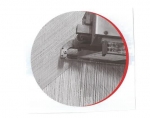Fabrics
3D Glass Fabric is a woven E-glass yarn and consists of two surface (deck) layers connected together by vertical links (piles). These links are woven together with the surface layers thus forming an integrated sandwich structure. When a thermoset resin such as polyester or epoxy is added to the 3D glass fabric and lightly rolled, the surface fabric is impregnated with the resin. Capillary action also wets out the connecting links, so that when the fabric rebounds to its full height it a hollow core is formed (much like the tree trunks is a forest). This one-step process forms a sandwich laminate that offers excellent strength, stiffness, lightweight and durability.
We use high performance carbon fiber rapier weaving machine and high quality creels for our woven fabrics.
Our multiaxial fabrics enable many different structures to be produced and offer greater stability with reduced material use. Our fabric is the most effective preliminary design reinforced fabric. Great design flexibility, resilient and isotropic strain capacity.
Carbon Fiber Fabrics can be used in the reinforcement of buildings, bridges and other important projects. It has excellent physical properties, able to bear high temperature, high-strength, if the modulus of carbon fiber fabric is the same as the one of the steel, its tensile strength is about 10 times higher than the steel's.
Basalt Fiber Fabric can be used in the reinforcement of less demanding projects such as wall cracks, etc. It not only has a very good high temperature performance it also has low-volume, low thermal conductivity, thermal shock resistance, flexibility, good abrasion resistance, folding endurance, high temperature resistance and other advantages.
Aramid Fiber Fabric can be used in the reinforcement of concrete structures, bridges and structures, civil structure and to enhance the strength. Kevlar fiber is the world's leading high-performance architectural fiber, can take advantage of its high-strength, high ductility and other characteristics of reinforcement to repair reinforced concrete and its structural performance of building structures.
S-Glass Fiber Fabric can be used for housing, bridge corrosion, and repair works. With the anti-aging properties, anti-cold, anti-humidity, light transmission is good, non-deformation, anti-ultraviolet, tensile strength, thermal expansion coefficient is small, the advantages of high-temperature.
E-Glass Fiber Fabric can be used in the reinforcement of less demanding projects such as wall cracks, etc. It has good fatigue resistance, good damage safety performance and the advantages of resistance to chemical corrosion.
H Fabrics are knitted with one or more layers of HCR/HM roving which are evenly distributed at single, biaxial or multi-axial direction. The specific fabric is designed to emphasize the mechanical strength in multi-direction. Used for applications such as: Blades for Wind Energy, Sports Device, Aerospace, Pipes, Tanks and Boats.







